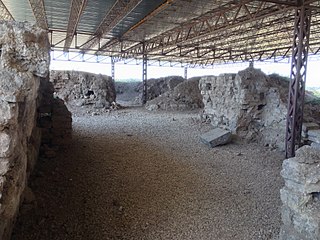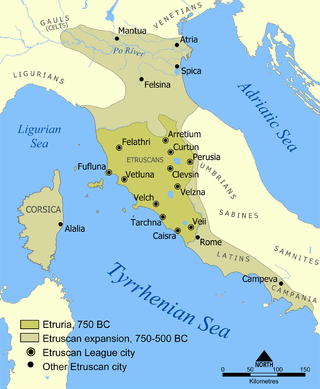Related Research Articles
The 2nd millennium BC spanned the years 2000 BC to 1001 BC. In the Ancient Near East, it marks the transition from the Middle to the Late Bronze Age. The Ancient Near Eastern cultures are well within the historical era: The first half of the millennium is dominated by the Middle Kingdom of Egypt and Babylonia. The alphabet develops. At the center of the millennium, a new order emerges with Mycenaean Greek dominance of the Aegean and the rise of the Hittite Empire. The end of the millennium sees the Bronze Age collapse and the transition to the Iron Age.

In Greek mythology, Cadmus was the legendary Greek hero and founder of Boeotian Thebes. He was, alongside Perseus and Bellerophon, the greatest hero and slayer of monsters before the days of Heracles. Commonly stated to be a prince of Phoenicia, the son of king Agenor and queen Telephassa of Tyre, the brother of Phoenix, Cilix and Europa, Cadmus traced his origins back to Poseidon and Libya.

Salamis was an ancient Greek city-state on the east coast of Cyprus, at the mouth of the river Pedieos, 6 km north of modern Famagusta. According to tradition, the founder of Salamis was Teucer, son of Telamon, king of the Greek island of Salamis, who could not return home after the Trojan War because he had failed to avenge his brother Ajax.
Mopsus was the name of one of two famous seers in Greek mythology; his rival being Calchas. A historical or legendary Mopsos or Mukšuš may have been the founder of a house in power at widespread sites in the coastal plains of Pamphylia and Cilicia during the early Iron Age.

Sybaris was an important ancient Greek city situated on the coast of the Gulf of Taranto in modern Calabria, Italy.
Ugarit was an ancient port city in northern Syria about 10 kilometers north of modern Latakia. At its height it ruled an area roughly equivalent to the modern Latakia Governorate. It was discovered by accident in 1928 with the Ugaritic texts. Its ruins are often called Ras Shamra after the headland where they lie.

The Greek Dark Ages was the period of Greek history from the end of the Mycenaean palatial civilization, around 1100 BC, to the beginning of the Archaic age, around 750 BC, It followed the so-called Late Bronze Age collapse of civilisation in the Eastern Mediterranean world in c. 1200-1150, as the great palaces and cities of the Mycenaeans were destroyed or abandoned. At around the same time, the Hittite civilization also suffered serious disruption, with cities from Troy to Gaza being destroyed. In Egypt, the New Kingdom fell into disarray, leading to the Third Intermediate Period of Egypt. Following the collapse, there were fewer, smaller settlements, suggesting widespread famine and depopulation. In Greece, the Linear B script used by Mycenaean bureaucrats to write the Greek language ceased to be used, and the Greek alphabet did not develop until the beginning of the archaic period. The decoration on Greek pottery after about 1100 BC lacks the figurative decoration of Mycenaean ware and is restricted to simpler, generally geometric styles (1000–700 BC).

Colonies in antiquity were post-Iron Age city-states founded from a mother-city or metropolis rather than a territory-at-large. Bonds between a colony and its metropolis often remained close, and took specific forms during the period of classical antiquity. Generally, colonies founded by the ancient Phoenicians, Carthage, Rome, Alexander the Great and his successors remained tied to their metropolis, though Greek colonies of the Archaic and Classical eras were sovereign and self-governing from their inception. While Greek colonies were often founded to solve social unrest in the mother-city by expelling a part of the population, Hellenistic, Roman, Carthaginian, and Han Chinese colonies were used for trade, expansion and empire-building.

Alalakh is an ancient archaeological site approximately 20 kilometres (12 mi) northeast of Antakya in what is now Turkey's Hatay Province. It flourished, as an urban settlement, in the Middle and Late Bronze Age, c. 2000-1200 BC. The city contained palaces, temples, private houses and fortifications. The remains of Alalakh have formed an extensive mound covering around 22 hectares. In Late Bronze Age, Alalakh was the capital of the local kingdom of Mukiš.

Naucratis or Naukratis was a city and trading-post in ancient Egypt, located on the Canopic (western-most) branch of the Nile river, south-east of the Mediterranean sea and the city of Alexandria. Naucratis was the first and, for much of its early history, the only permanent Greek settlement in Egypt, serving as a symbiotic nexus for the interchange of Greek and Egyptian art and culture.

Caere is the Latin name given by the Romans to one of the larger cities of southern Etruria, the modern Cerveteri, approximately 50–60 kilometres north-northwest of Rome. To the Etruscans it was known as Cisra, to the Greeks as Agylla and to the Phoenicians as 𐤊𐤉𐤔𐤓𐤉𐤀.

Balakros, also Balacrus, the son of Nicanor, one of Alexander the Great's "Somatophylakes" (bodyguards), was appointed satrap of Cilicia after the Battle of Issus, 333 BC. He succeeded to the last Achaemenid satrap of Cilicia, Arsames.

In the Archaic phase of ancient Greek art, the Orientalizing period or Orientalizing revolution is the cultural and art historical period that began during the later part of the 8th century BC, when there was a heavy influence from the more advanced art of the Eastern Mediterranean and the Ancient Near East. The main sources were Syria and Assyria as well as Phoenicia and Egypt. With the spread of Phoenician civilization by Carthage and Greek colonisation into the Western Mediterranean, these artistic trends also influenced the Etruscans and early Ancient Romans in the Italian peninsula.

Jebel Aqra is a limestone mountain located on the Syrian–Turkish border near the mouth of the Orontes River on the Mediterranean Sea. Rising from a narrow coastal plain, Jebel Aqra is a mariners' landmark which gathers thunderstorms.

Greek colonisation refers to the expansion of Archaic Greeks, particularly during the 8th–6th centuries BC, across the Mediterranean Sea and the Black Sea.

Ras Ibn Hani, Ugaritic Raʾšu, is a small cape located 8 kilometers (5.0 mi) north of Latakia, Syria on the Mediterranean Sea. It is an important archaeological site as it was occupied almost continuously from the late Bronze Age until Byzantine times. The site now is in a major resort area called the Cote d'Azur of Syria.
The siege of Segesta took place either in the summer of 398 BC or the spring of 397 BC. Dionysius the Elder, tyrant of Syracuse, after securing peace with Carthage in 405 BC, had steadily increased his military power and tightened his grip on Syracuse. He had fortified Syracuse against sieges and had created a large army of mercenaries and a large fleet, in addition to employing catapults and quinqueremes for the first time in history. In 398 BC he attacked and sacked the Phoenician city of Motya despite a Carthaginian relief effort led by Himilco II of Carthage. While Motya was under siege, Dionysius besieged and assaulted Segesta unsuccessfully. Following the sack of Motya, Segesta again came under siege by Greek forces, but the Elymian forces based in Segesta managed to inflict damage on the Greek camp in a daring night assault. When Himilco of Carthage arrived in Sicily with the Carthaginian army in the spring of 397 BC, Dionysius withdrew to Syracuse. The failure of Dionysius to secure a base in western Sicily meant the main events of the Second Sicilian war would be acted out mostly in eastern Sicily, sparing the Elymian and Phoenician cities the ravages of war until 368 BC.
Ras al-Bassit, the classical Posidium or Posideium, is a small town in Syria named for a nearby cape. It has been occupied since at least the late Bronze Age and was a fortified port under Greek and Roman rule. Herodotus—although not later classical geographers—made it the northwestern point of Syria. Its beaches have a distinctive black sand and are a popular resort destination within Syria.
Tell Sukas is a Late Bronze Age archaeological mound on the Eastern Mediterranean coast about 6 kilometres (3.7 mi) south of Jableh, Syria.
In Greek mythology, Carmanor or Karmanor was a Cretan priest who purified Apollo after he killed the Delphic dragon Python. He was the father of two children Euboulus and Chrysothemis. According to Walter Burkert the name Carmanor "does not appear to be Greek".
References
- Boardman, John (1980). The Greeks Overseas: Their Early Colonies and Trade . London: Thames and Hudson. ISBN 0-500-25069-3.
- ——— (1990). "Al-Mina and history" Oxford Journal of Archaeology9 pp 169–90. doi : 10.1111/j.1468-0092.1990.tb00221.x
- Braun, T.F.R.G. (1982). "The Greeks in the Near East" in Cambridge Ancient History III.3 (Cambridge University Press)
- Burkert, Walter (1992). The Orientalizing Revolution: Near Eastern Influences on Greek Culture in the Early Archaic Age. Cambridge, MA: Harvard University Press. ISBN 0-674-64363-1.
- Coldstream, J.N. (1982). "Greeks and Phoenicians in the Aegean" and P.J. Riis "Griechen in Phönizien" in H.G. Niemeyer, Phönizier im Westen. Mainz, pp 261–72 and 237-55. ISBN 3-8053-0486-2
- Lane Fox, Robin (2008) Travelling Heroes in the Epic Age of Homer (New York:Knopf) In the UK Travelling Heroes: Greeks and Their Myths in the Epic Age of Homer(London: Allen Lane, Penguin Books), 2008
- Lehmann, G. (2005). “Al-Mina and the East: A Report on Research in Progress,” in Alexandra Villing (ed.), The Greeks in the East. London: British Museum Research Publication vol. 157, pp. 61–92. ISBN 0-86159-157-7
- Luke, Joanna (2003). Ports of Trade: Al Mina and Geometric Greek Pottery in the Levant. Oxford: Archaeopress. ISBN 1-84171-478-X.
- Waldbaum, Jane C. (1997). "Greeks in the East or Greeks and the East?: Problems in the Definition and Recognition of Presence". Bulletin of the American Schools of Oriental Research. 305 (305): 1–17 : https://www.jstor.org/stable/1357743. doi:10.2307/1357743. JSTOR 1357743. S2CID 164205841.
- Woolley, Leonard (1948). "The Date of Al-Mina". Journal of Hellenic Studies . 68: 148. doi:10.2307/626304. JSTOR 626304. S2CID 164043912.
- ——— (1953). A Forgotten Kingdom (Harmondsworth: Penguin)